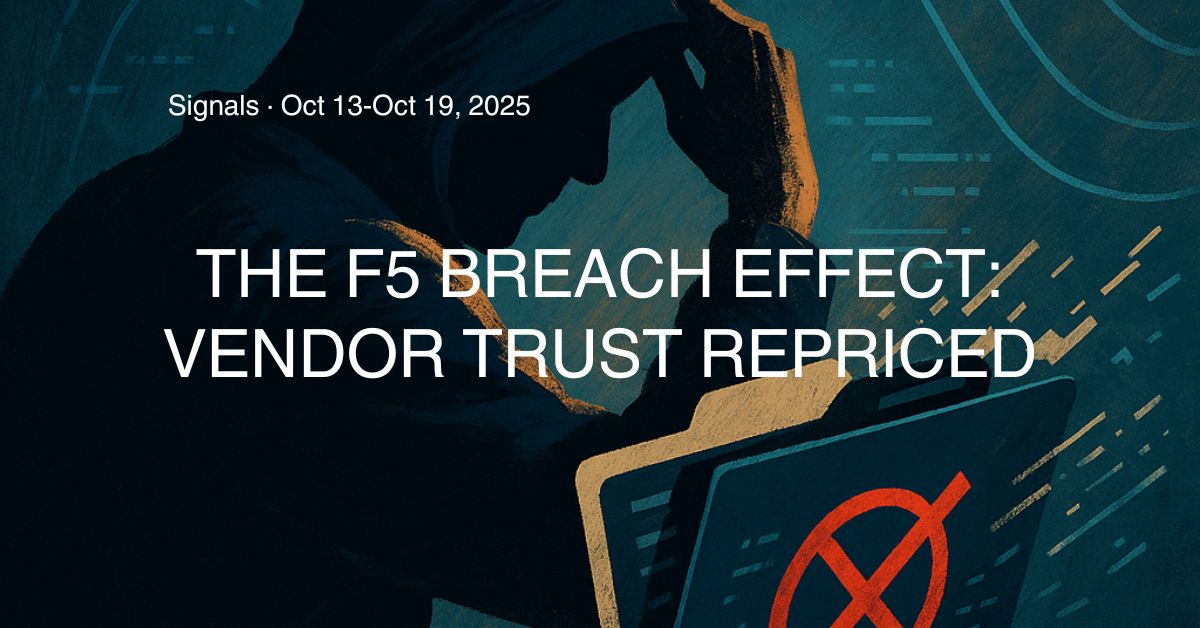- Vendor confidence shifted. A nation-state breach at F5, involving stolen source code and vulnerability research, accelerated a move toward stricter supplier verification.
- Response speed is increasing. The Cybersecurity and Infrastructure Security Agency (CISA) issued Emergency Directive 26-01 with ten-day deadlines for inventory, isolation, and patching. Large buyers are beginning to adopt similar timeframes in their own governance processes.
- Procurement standards are rising. Software Bills of Materials (SBOMs), code-signing attestations, and secure Software Development Life Cycle (SDLC) documentation are becoming conditions for doing business.
- Winners are likely to be vendors who can demonstrate software integrity, automate remediation, and offer packaged emergency-directive response solutions that help customers comply faster.
Incident Summary
In mid-October, F5 confirmed that a nation-state actor gained long-term access to its internal systems and stole portions of BIG-IP source code along with internal vulnerability research. The company stated that customer data and production binaries were not affected, but the breach raised questions about how its development environment is secured.
Soon after, CISA issued Emergency Directive (ED) 26-01, requiring all federal agencies to inventory affected F5 systems, disconnect exposed management interfaces, apply available patches, and report completion by October 22 and October 29, 2025. The directive treated the breach as a supply-chain exposure rather than a traditional IT incident and established specific deadlines for mitigation.
F5’s products include load balancers, SSL VPNs, and traffic managers used across banks, government networks, and critical industries. Independent scans suggest between 266,000 and 600,000 internet-reachable devices, depending on scan methodology; real exposure is higher when internal deployments are included. While F5 stated that no tampering was found in the released code, stolen vulnerability research could enable attackers to identify new exploit paths faster.
For security teams, patching was only part of the response. Boards began asking for evidence of completion, asset inventories, and isolation measures. The conversation soon extended beyond F5. SonicWall confirmed theft of credentials from its SSL VPN systems. Adobe added its Experience Manager (AEM) platform to the Known Exploited Vulnerabilities (KEV) list. Zendesk reported ticket-abuse campaigns that mimicked support communications. Together, these incidents showed how interconnected the software supply chain has become.
CISA’s directive introduced a new sense of urgency. Enterprises outside the federal sphere are aligning internal patch cycles to CISA’s structure, and procurement teams are revising templates to require SBOMs, signed build proofs, KEV-aligned Service Level Agreements (SLAs), and third-party audit reports. For an industry accustomed to quarterly disclosure cycles, this reflects a clear acceleration in how trust is verified.
What We Still Do Not Know
- Whether stolen research will lead to new vulnerabilities unique to F5 platforms
- Whether any customer configuration data was accessed at scale
Investor Lens: What’s Changing
Assurance as a Product Category
Supply-chain assurance is evolving from manual consulting to software. Companies that provide SBOM validation, secure-build monitoring, or continuous evidence generation are already attracting investor attention. Governance, Risk, and Compliance (GRC) tools and DevSecOps platforms are converging toward continuous attestation models priced as subscription modules per managed asset.
Platformization and Managed Accountability
Enterprises increasingly prefer partners who assume outcome responsibility. Managed Detection and Response (MDR) providers are acquiring or integrating product vendors to deliver full-stack assurance. The LevelBlue acquisition of Cybereason illustrates this trend: service providers are buying technology assets to deliver measurable results and improve gross-margin efficiency.
Margin Pressure on Appliance Vendors
Traditional hardware and appliance vendors face new fixed costs for external audits, SBOM portals, and reproducible-build infrastructure. Their gross margins will tighten unless they offset compliance expenses through subscription pricing or migration to cloud-native architectures with built-in provenance.
Capital Rotation to Verifiable Platforms
Investors are favoring companies that can demonstrate measurable efficacy and integrity. Examples include AI-assisted Security Operations Center (SOC) benchmarking, such as Microsoft ExCyTIn-Bench and identity-centric security.. Valuations increasingly reward transparency and quantifiable performance rather than broad innovation claims.
Strategic Implications for Vendors
Assurance Becomes a Feature
Vendors are under growing pressure to prove how their software is built, not just how it performs. Demonstrating integrity through transparent SBOMs, code-signing, and secure development practices is becoming part of the sales narrative. The ability to show proof of control will soon weigh as much as functionality in purchase decisions.
Agility Defines Trust
The F5 incident revealed how quickly the definition of “timely response” can change. As emergency directives and compliance windows tighten, vendors that can move from detection to evidence in days rather than weeks will gain a reputational advantage. Agility itself is becoming a measure of reliability.
Secure Development
Investors and enterprise buyers are beginning to treat secure SDLC maturity as an indicator of organizational discipline. Vendors that can articulate their development safeguards in clear, non-technical terms are more likely to win trust from boards and procurement teams.
Ecosystem Risk Comes Under Scrutiny
Third-party code and integrations are emerging as a new layer of due diligence. Vendors will be expected to map and monitor dependencies across their supply chain and provide evidence of oversight. The conversation is shifting from individual product risk to ecosystem accountability.
Cyber Due Diligence Gains Weight in M&A
The acquisition process is expanding beyond traditional financial or market checks. Buyers are now examining software integrity, building provenance, and regulatory alignment before closing deals. Cyber maturity is becoming a valuation factor, not just a compliance checkbox.
Why This Matters
The F5 breach marks a transition from assumed trust to demonstrated trust in cybersecurity infrastructure. Vendor integrity has become a measurable and auditable quality that directly affects sales, renewals, and valuations.
For buyers, assurance has replaced reassurance. Procurement is asking for evidence rather than statements. For vendors, transparency is no longer a compliance exercise but a component of competitiveness.
The next advantage will come less from adding new features and more from proving the reliability of what already exists.
